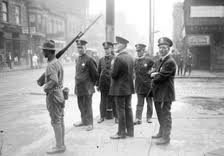
The year 1919 was a tremendous year in the twentieth century. It was the year that the map of the world was redrawn. World War I ended at the Treaty of Versailles that year. Germany and her allies were devastated. Meanwhile, Russia was embroiled in civil war between traditional “whites” and bolshevik “reds”. The Allies attempted to keep Russia “white” with a series of military expeditions. The British, Japanese and Americans, among others, briefly occupied Russian soil. Eventually, they withdrew. The United States was also facing issues with radicals at home.
The “Second” Industrial Revolution had created an environment of radicalism in the United States. The considerable gap between the “robber barons” and their masses of workers was just the kind of environment that nurtured “radical” idealism. Socialism grew in popularity, especially among the working classes in large, Northern cities. Anarchists, many of them foreign immigrants, held rallies and seemed to always find themselves in the midst of trouble. It was a group of German anarchists who were accused of conspiracy after the infamous Haymarket Riot in 1886.
By 1919, radicalism was on the rise. It was growing, especially among the labor unions. Labor unions in Seattle organized a massive strike and practically shut the city down. Attorney General Mitchell Palmer’s house was bombed by anarchists. In response, Palmer initiated a “witch hunt” for suspected radicals. This involved deporting those deemed “dangerous”. Radical feminist and anarchist, Emma Goldman, was deported during this “First Red Scare”. There was increased paranoia regarding radicals and a growing fear that the Bolshevik Revolution in Russia would repeat itself in the United States.
Political leftists (and in the case of anarchists, extreme rightists) were not the only ones who suffered during the year of 1919. The return of World War I veterans and the Great Migration, an influx of African-Americans from the South to large cities in the North and Midwest, caused increased tension between blacks and whites. This resulted in the ugly “Red Summer” race riots. The worst rioting occurred in Chicago, Washington D.C. as well as terrible riots in Elaine, Arkansas and Omaha, Nebraska.
Mitchell Palmer predicted a major radical revolution on May 1, 1920. The day passed with no revolution. This effectively ended the First Red Scare. Eventually, the government restored order in the rioting cities of the Midwest and ended the Red Summer. 1919 ended and all seemed well. America entered the “Roaring Twenties” and it seemed to many that problems were something of the past. However, the worst was yet to come. If 1919 can be called the Red Year, then 1929 can be called the Black Year: a major crash in the stock market would put the “roar” to an end.
